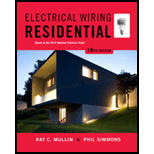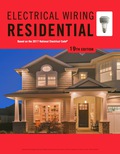
Concept explainers
In the spaces provided, fill in the cover (depth) for the following residential underground installations. See NEC Table 300.5.
- a. Type UF. No other protection. ______________________ in.
- b. Type UF below driveway. ______________________ in.
- c. Rigid metal conduit under lawn. ______________________ in.
- d. Rigid metal conduit under driveway. ______________________ in.
- e. Electrical metallic tubing between house and detached garage. ______________________ in.
- f. UF cable under lawn. Circuit is 120 volts, 20 amperes, GFCI protected. ______________________ in.
- g. Rigid PVC conduit approved for direct burial. No other protection. ______________________ in.
- h. Rigid PVC conduit. Circuit is 120 volts, 20 amperes, GFCI protected. ______________________ in.
- i. Rigid conduit passing over solid rock and covered by 2 in. (50 mm) of concrete extending down to rock. ______________________ in.
a.
Find the cover (depth) for Type UF with no other protection.
Answer to Problem 13R
The cover (depth) for Type UF with no other protection is
Explanation of Solution
Discussion:
The National Electrical Code committee develops NEC – the standard electrical Code and the main objective for the origin of the Code is to protect and safeguard people and elements from electrical hazards. The codes for explaining underground installations are defined in an article NEC 300.5.
According to the table NEC Table 300.5, the depth for the circuits used for control of the irrigation and landscape lighting with Type UF for non-protected areas like streets, driveways, highways, parking lots, and roads is
Conclusion:
Thus, the cover (depth) for Type UF with no other protection is
b.
Find the cover (depth) for Type UF below driveway.
Answer to Problem 13R
The cover (depth) for Type UF below driveway is
Explanation of Solution
Discussion:
According to the table NEC Table 300.5, the depth for the circuits used for control of the irrigation and landscape lighting with Type UF for outdoor parking areas, areas used for dwelling purposes and dwelling driveways for one and two families is
Conclusion:
Thus, the cover (depth) for Type UF below driveway is
c.
Find the cover (depth) for the rigid metal conduit under lawn.
Answer to Problem 13R
The cover (depth) for the rigid metal conduit under lawn is
Explanation of Solution
Discussion:
According to the table NEC Table 300.5, the depth for the rigid or intermediate metal conduit under lawn areas is
Conclusion:
Thus, the cover (depth) for the rigid metal conduit under lawn is
d.
Find the cover (depth) for the rigid metal conduit under driveway.
Answer to Problem 13R
The cover (depth) for the rigid metal conduit under driveway is
Explanation of Solution
Discussion:
According to the table NEC Table 300.5, the depth for the rigid or intermediate metal conduit for parking areas in outdoor section, areas for dwelling purposes and dwelling driveways for one and two families is
Conclusion:
Thus, the cover (depth) for the rigid metal conduit under driveway is
e.
Find the cover (depth) for electrical metallic tubing between house and detached garage.
Answer to Problem 13R
Electric metallic tubing is not permitted for underground installations.
Explanation of Solution
Discussion:
Electrical metallic tubing is an unthreaded thin-wall raceway of the circular cross section which is designed for physical protection purposes and routing purposes for the cables and conductors. When utilizing appropriate fittings are installed, this tubing is used as an equipment grounding conductor.
Electrical metallic tubing cannot be used for residential underground installations.
Conclusion:
Thus, the electric metallic tubing is not permitted for underground installations.
f.
Find the cover (depth) for the UF cable under lawn, circuit with
Answer to Problem 13R
The cover (depth) for the UF cable under lawn, circuit with
Explanation of Solution
Discussion:
According to the table NEC Table 300.5, the depth for the residential branch circuits rated with
Conclusion:
Thus, the cover (depth) for the UF cable under lawn, circuit with
g.
Find the cover (depth) for the rigid PVC conduit approved for direct burial with no other protection.
Answer to Problem 13R
The cover (depth) for the rigid PVC conduit approved for direct burial with no other protection is
Explanation of Solution
Discussion:
The rigid PVC is a non-metal. According to the table NEC Table 300.5, the depth for the nonmetallic raceways that are listed for non-burial without the concrete encasement with no other protection is
Conclusion:
Thus, the cover (depth) for the rigid PVC conduit approved for direct burial with no other protection is
h.
Find the cover (depth) for the rigid PVC conduit circuit with
Answer to Problem 13R
The cover (depth) for the rigid PVC conduit circuit with
Explanation of Solution
Discussion:
According to the table NEC Table 300.5, the depth for the residential branch circuits rated with
Conclusion:
Thus, the cover (depth) for the rigid PVC conduit circuit with
i.
Find the cover (depth) for the rigid conduit passing over the solid rock.
Answer to Problem 13R
The cover (depth) for the rigid conduit passing over the solid rock is
Explanation of Solution
Discussion:
According to an article NEC 300.5, Note 5 to Table 300.5, the wiring should be installed in metal raceway or the nonmetallic raceway that are permitted for direct burial where the solid rock prevents the compliances with the cover values. The cover of the raceway should be covered by minimum of
Conclusion:
Thus, the cover (depth) for the rigid conduit passing over the solid rock is
Want to see more full solutions like this?
Chapter 16 Solutions
Electrical Wiring Residential
Additional Engineering Textbook Solutions
BASIC BIOMECHANICS
Starting Out With Visual Basic (8th Edition)
Degarmo's Materials And Processes In Manufacturing
Mechanics of Materials (10th Edition)
Fluid Mechanics: Fundamentals and Applications
Starting Out with Programming Logic and Design (5th Edition) (What's New in Computer Science)
- Please solve it by explaining the steps. I am trying to prepare for my exam today, so any tips and tricks to solve similar problems are highly appreciated. Plus, this is a past exam I am using to prepare.arrow_forwardIf C is the circle |z|=4 evaluate f f (z)dz for each of the following functions using residue. 1 f(z) = z(z²+6z+4)arrow_forwardIf C is the circle |z|=4 evaluate ff(z)dz for each of the following functions using residue. f(z) z(z²+6z+4)arrow_forward
- Determine X(w) for the given function shown in Figure (1) by applying the differentiation property of the Fourier Transform. 1 x(t) Figure (1) -2 I -1 1 2arrow_forwardPlease solve it by explaining the steps. I am trying to prepare for my exam tomorrow, so any tips and tricks to solve similar problems are highly appreciated. Plus, this is a past exam I am using to prepare.arrow_forwardPlease solve it by explaining the steps. I am trying to prepare for my exam tomorrow, so any tips and tricks to solve similar problems are highly appreciated. Plus, this is a past exam I am using to prepare.arrow_forward
- Please solve it by explaining the steps. I am trying to prepare for my exam tomorrow, so any tips and tricks to solve similar problems are highly appreciated. Plus, this is a past exam I am using to prepare.arrow_forwardPlease solve it by explaining the steps. I am trying to prepare for my exam tomorrow, so any tips and tricks to solve similar problems are highly appreciated. Plus, this is a past exam I am using to prepare.arrow_forwardPlease solve it by explaining the steps. I am trying to prepare for my exam tomorrow, so any tips and tricks to solve similar problems are highly appreciated. Plus, this is a past exam I am using to prepare.arrow_forward
- Please solve it by explaining the steps. I am trying to prepare for my exam tomorrow, so any tips and tricks to solve similar problems are highly appreciated. Plus, this is a past exam I am using to prepare.arrow_forwardPlease solve it by explaining the steps. I am trying to prepare for my exam tomorrow, so any tips and tricks to solve similar problems are highly appreciated. Plus, this is a past exam I am using to prepare.arrow_forwardPlease solve it by explaining the steps. I am trying to prepare for my exam tomorrow, so any tips and tricks to solve similar problems are highly appreciated. Plus, this is a past exam I am using to prepare.arrow_forward
 EBK ELECTRICAL WIRING RESIDENTIALElectrical EngineeringISBN:9781337516549Author:SimmonsPublisher:CENGAGE LEARNING - CONSIGNMENT
EBK ELECTRICAL WIRING RESIDENTIALElectrical EngineeringISBN:9781337516549Author:SimmonsPublisher:CENGAGE LEARNING - CONSIGNMENT
